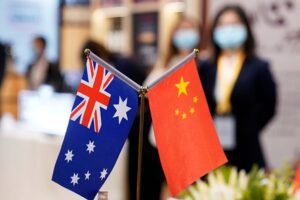
In a momentous diplomatic maneuver for rebuilding Australia-China relations, Australian Prime Minister Anthony Albanese is poised to embark on a historic sojourn to China, marking the inaugural visit by an Australian leader in seven years. This voyage carries immense gravitas as it endeavors to mend the frayed ties between Australia and China, paving the way for augmented collaboration across diverse domains. Within the depths of this discourse, we shall delve into the underlying catalysts of discord between these two nations, elucidate the objectives underpinning this pivotal visit, and scrutinize the profound ramifications for both realms.
Understanding the Australia-China Strained Relations
Root Causes of Discord: The discordant rapport between Australia and China finds its roots in a multitude of factors:
- Trade Disputes: A significant driver of strain emanates from trade tensions. Australia’s advocacy for an independent inquiry into the origins of the COVID-19 pandemic, construed by China as a targeted affront, precipitated economic reprisal in the form of trade constraints on Australian exports.
- Geopolitical Quandaries: Divergent perspectives on regional geopolitical quandaries, notably concerning the South China Sea, have compounded the strain. Australia’s allegiance to the U.S. in the region and its stance on territorial disputes have misaligned with China’s vested interests.
- Human Rights Apprehensions: Australia’s vocal censure of China’s human rights track record, particularly concerning Xinjiang and Hong Kong, has emerged as a contentious juncture in bilateral relations.
- Foreign Influence Legislation: The enactment of foreign influence laws in Australia, designed to counter perceived meddling from China in domestic affairs, further escalated tensions.
- Technological and Security Anxieties: Concerns regarding China’s involvement in Australia’s telecommunications infrastructure and potential security hazards have also cast a shadow on relations.
Objectives of the Diplomatic Meeting
- Diplomatic Reconciliation: Foremost among the objectives of Prime Minister Albanese’s visit is the recalibration of diplomatic ties between Australia and China. The seven-year hiatus since the last high-level visit underscores the urgency of restoring this relationship.
- Economic Collaborative Endeavors: A pivotal goal of this visit lies in the reinvigoration of economic affiliations between the two nations. China stands as a pivotal trading partner for Australia, and normalized trade relations hold mutual benefits for both parties.
- Security and Regional Equilibrium: Both nations share a vested interest in regional stability. This visit affords an opportune moment to address shared security concerns, including the North Korean conundrum, and explore avenues for collaboration in this sphere.
- Bridging Discord: Albanese’s diplomatic venture aspires to tackle the underlying issues straining relations, encompassing trade, human rights, and security apprehensions. Through constructive dialogue, both nations aim to unearth common ground and foster a more cooperative relationship.
Implications of the Diplomatic Meeting
- Economic Revitalization: A successful visit holds the promise of dismantling trade barriers and bolstering economic bonds between Australia and China. Australian sectors, notably agriculture, weathered challenges due to trade disputes, and a resolution could herald substantial economic dividends.
- Regional Serenity: Amplified collaboration on regional security concerns can contribute substantially to stability in the Asia-Pacific region. As influential stakeholders, their joint efforts can exert a positive influence on regional dynamics.
- Diplomatic Landmark: This visit constitutes a momentous milestone in the diplomatic entente between Australia and China. It signifies a willingness to engage in dialogue and resolve differences, potentially triggering a ripple effect in global politics.
- Geopolitical Equilibrium: Australia’s nuanced approach to managing its relationship with China while upholding its alliance with the United States assumes significance in the broader geopolitical equilibrium of the Indo-Pacific region. A successful visit could aid Australia in navigating this intricate balancing act.
- Human Rights and Ethical Standpoint: The visit also provides an avenue for Australia to articulate its concerns regarding human rights issues in China. Balancing economic interests with ethical values and principles poses a challenge faced by many nations in their interactions with China.
Journey Following the US-Australia Meeting

Notably, Prime Minister Albanese’s visit to China follows closely on the heels of a high-profile meeting between the leaders of the United States and Australia. The recent US-Australia summit highlighted the strong strategic alliance between the two nations and their shared concerns about regional security and the expansion of China’s influence. The proximity of these events underscores Australia’s delicate balancing act in the realm of international diplomacy.
While reaffirming its alliance with the United States, Australia is also demonstrating its commitment to engaging with China and improving bilateral relations. This visit can be seen as an attempt to navigate the complex geopolitics of the Asia-Pacific region and protect its economic and security interests.
Conclusion

The visit of Australian Prime Minister Anthony Albanese to China after seven years of strained relations is a momentous development with far-reaching implications. It represents a significant step towards rebuilding diplomatic ties, reviving economic cooperation, and promoting regional stability. This visit, occurring in the wake of a crucial US-Australia meeting, showcases Australia’s nuanced approach to international relations and its efforts to maintain a balance between its strategic alliances and its vital economic relationships. As Australia and China engage in dialogue during this visit, the world will be watching closely, hoping for progress in resolving disputes, fostering cooperation, and contributing to global stability and prosperity.










